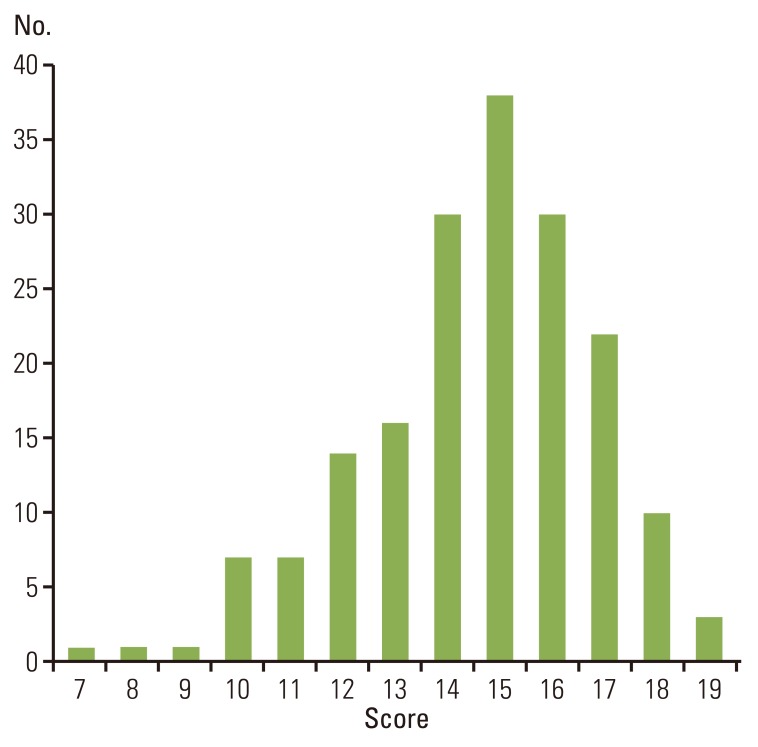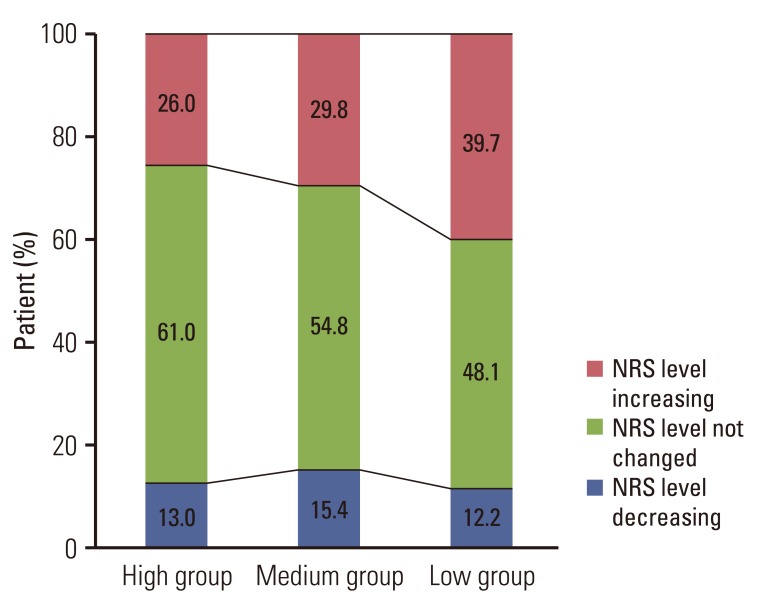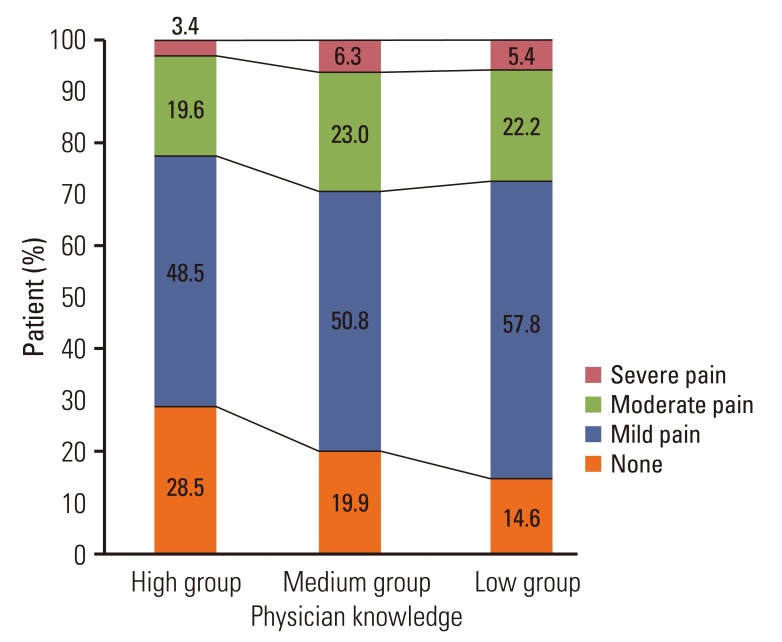Cancer Res Treat.
2014 Apr;46(2):131-140.
A Nationwide Survey of Knowledge of and Compliance with Cancer Pain Management Guidelines by Korean Physicians
- Affiliations
-
- 1Department of Internal Medicine, Dongguk University Ilsan Hospital, Dongguk University College of Medicine, Goyang, Korea.
- 2Department of Medicine, Samsung Medical Center, Sungkyunkwan University School of Medicine, Seoul, Korea.
- 3Department of Internal Medicine, Yeungnam University College of Medicine, Daegu, Korea.
- 4Department of Internal Medicine, Chonnam National University Hwasun Hospital, Chonnam National University Medical School, Hwasun, Korea.
- 5Department of Biostatistics, Korea University College of Medicine, Seoul, Korea.
- 6Department of Internal Medicine, Kyung Hee University Hospital, Kyung Hee University School of Medicine, Seoul, Korea. sykim@khu.ac.kr
Abstract
- PURPOSE
Although cancer pain is prevalent, under-treatment still remains a problem. Knowledge of and compliance with guidelines for management of cancer pain were analyzed for exploration of physician-related barriers to cancer pain management. In addition, physicians' knowledge and its correlation with cancer pain control were audited.
MATERIALS AND METHODS
From July 8 to December 2, 2010, a nationwide survey of house staff enquired about their knowledge of cancer pain control guidelines, and the medical records of patients under their care were analyzed.
RESULTS
In total, 180 physicians participated in the study. Their average score for knowledge was 14.6 (range, 7 to 19; maximum possible, 20). When the knowledge score was divided into low, medium, and high scores, patients receiving care from physicians with high levels of knowledge tended to have better cancer pain control (p<0.001). Of the total patients with severe pain, 19.5% were not prescribed strong opioids, and 40% were not prescribed any medication for breakthrough pain.
CONCLUSION
Physicians' knowledge of guidelines for control of cancer pain showed an association with improvement of pain management. Overall adherence to the guidelines was lacking. Continuous interventions such as education and audits regarding cancer pain control guidelines for physician are needed.
Keyword
MeSH Terms
Figure
Reference
-
1. van den Beuken-van Everdingen MH, de Rijke JM, Kessels AG, Schouten HC, van Kleef M, Patijn J. Prevalence of pain in patients with cancer: a systematic review of the past 40 years. Ann Oncol. 2007; 18:1437–1449. PMID: 17355955.2. Benedetti C, Brock C, Cleeland C, Coyle N, Dube JE, Ferrell B, et al. NCCN practice guidelines for cancer pain. Oncology (Williston Park). 2000; 14:135–150. PMID: 11195407.3. World Health Organization. Cancer pain relief: with a guide to opioid availability. 2nd ed. Geneva: World Health Organization;1996.4. Deandrea S, Montanari M, Moja L, Apolone G. Prevalence of undertreatment in cancer pain. A review of published literature. Ann Oncol. 2008; 19:1985–1991. PMID: 18632721.
Article5. Hong SH, Roh SY, Kim SY, Shin SW, Kim CS, Choi JH, et al. Change in cancer pain management in Korea between 2001 and 2006: results of two nationwide surveys. J Pain Symptom Manage. 2010; 9. 24. [Epub ahead of print].
Article6. Oldenmenger WH, Sillevis Smitt PA, van Dooren S, Stoter G, van der Rijt CC. A systematic review on barriers hindering adequate cancer pain management and interventions to reduce them: a critical appraisal. Eur J Cancer. 2009; 45:1370–1380. PMID: 19201599.
Article7. Yu S, Wang XS, Cheng Y, Yang J, Cleeland CS. Special aspects of cancer pain management in a Chinese general hospital. Eur J Pain. 2001; 5(Suppl A):15–20. PMID: 11798212.
Article8. Ger LP, Ho ST, Wang JJ. Physicians' knowledge and attitudes toward the use of analgesics for cancer pain management: a survey of two medical centers in Taiwan. J Pain Symptom Manage. 2000; 20:335–344. PMID: 11068155.9. Wolfert MZ, Gilson AM, Dahl JL, Cleary JF. Opioid analgesics for pain control: wisconsin physicians' knowledge, beliefs, attitudes, and prescribing practices. Pain Med. 2010; 11:425–434. PMID: 20002590.
Article10. Kim MH, Park H, Park EC, Park K. Attitude and knowledge of physicians about cancer pain management: young doctors of South Korea in their early career. Jpn J Clin Oncol. 2011; 41:783–791. PMID: 21502282.
Article11. de Rond ME, de Wit R, van Dam FS, van Campen BT, den Hartog YM, Klievink RM. A pain monitoring program for nurses: effects on nurses' pain knowledge and attitude. J Pain Symptom Manage. 2000; 19:457–467. PMID: 10908826.12. Francke AL, Luiken JB, de Schepper AM, Abu-Saad HH, Grypdonck M. Effects of a continuing education program on nurses' pain assessment practices. J Pain Symptom Manage. 1997; 13:90–97. PMID: 9095566.
Article13. Ger LP, Chang CY, Ho ST, Lee MC, Chiang HH, Chao CS, et al. Effects of a continuing education program on nurses' practices of cancer pain assessment and their acceptance of patients' pain reports. J Pain Symptom Manage. 2004; 27:61–71. PMID: 14711470.
Article14. Kim HT, Koh KW, Kim YM, Kang MS, Noh HS, Kim HR, et al. Pain management based on NCCN guideline in patients with lung cancer. Tuberc Respir Dis. 2009; 67:221–225.
Article15. Elliott TE, Elliott BA. Physician attitudes and beliefs about use of morphine for cancer pain. J Pain Symptom Manage. 1992; 7:141–148. PMID: 16967581.
Article16. Elliott TE, Murray DM, Elliott BA, Braun B, Oken MM, Johnson KM, et al. Physician knowledge and attitudes about cancer pain management: a survey from the Minnesota cancer pain project. J Pain Symptom Manage. 1995; 10:494–504. PMID: 8537691.
Article17. Weinstein SM, Laux LF, Thornby JI, Lorimor RJ, Hill CS Jr, Thorpe DM, et al. Physicians' attitudes toward pain and the use of opioid analgesics: results of a survey from the Texas Cancer Pain Initiative. South Med J. 2000; 93:479–487. PMID: 10832945.18. Temel JS, Greer JA, Muzikansky A, Gallagher ER, Admane S, Jackson VA, et al. Early palliative care for patients with metastatic non-small-cell lung cancer. N Engl J Med. 2010; 363:733–742. PMID: 20818875.
Article19. Gallagher R, Hawley P, Yeomans W. A survey of cancer pain management knowledge and attitudes of British Columbian physicians. Pain Res Manag. 2004; 9:188–194. PMID: 15605132.
Article20. Rethans JJ, Sturmans F, Drop R, van der Vleuten C, Hobus P. Does competence of general practitioners predict their performance? Comparison between examination setting and actual practice. BMJ. 1991; 303:1377–1380. PMID: 1760606.
Article21. Eccles M, Ford GA, Duggan S, Steen N. Are postal questionnaire surveys of reported activity valid? An exploration using general practitioner management of hypertension in older people. Br J Gen Pract. 1999; 49:35–38. PMID: 10622014.22. Thota RS, Jain P, Bakshi SG, Dhanve CN. Opioid-prescribing practices in chronic cancer pain in a tertiary care pain clinic. Indian J Palliat Care. 2011; 17:222–226. PMID: 22346047.
Article23. Hakonsen GD, Hudson S, Loennechen T. Design and validation of a medication assessment tool for cancer pain management. Pharm World Sci. 2006; 28:342–351. PMID: 17120130.
Article24. Hakonsen GD, Strelec P, Campbell D, Hudson S, Loennechen T. Adherence to medication guideline criteria in cancer pain management. J Pain Symptom Manage. 2009; 37:1006–1018. PMID: 19500723.
- Full Text Links
- Actions
-
Cited
- CITED
-
- Close
- Share
- Similar articles
-
- Commentary on "A Nationwide Survey of Knowledge of and Compliance with Cancer Pain Management Guidelines by Korean Physicians"
- Reply to Commentary on "A Nationwide Survey of Knowledge of and Compliance with Cancer Pain Management Guidelines by Korean Physicians"
- Real-World Compliance of Surgical Treatment According to the Korean Gastric Cancer Guideline 2018: Evaluation From the Nationwide Survey Data 2019 in Korea
- Resident's Knowledge and Attitude towards Cancer Pain Management
- Structural Model of Hospital Nurses’ Compliance with Antineoplastic Drugs Safety Management Guidelines Based on Theory of Planned Behavior




